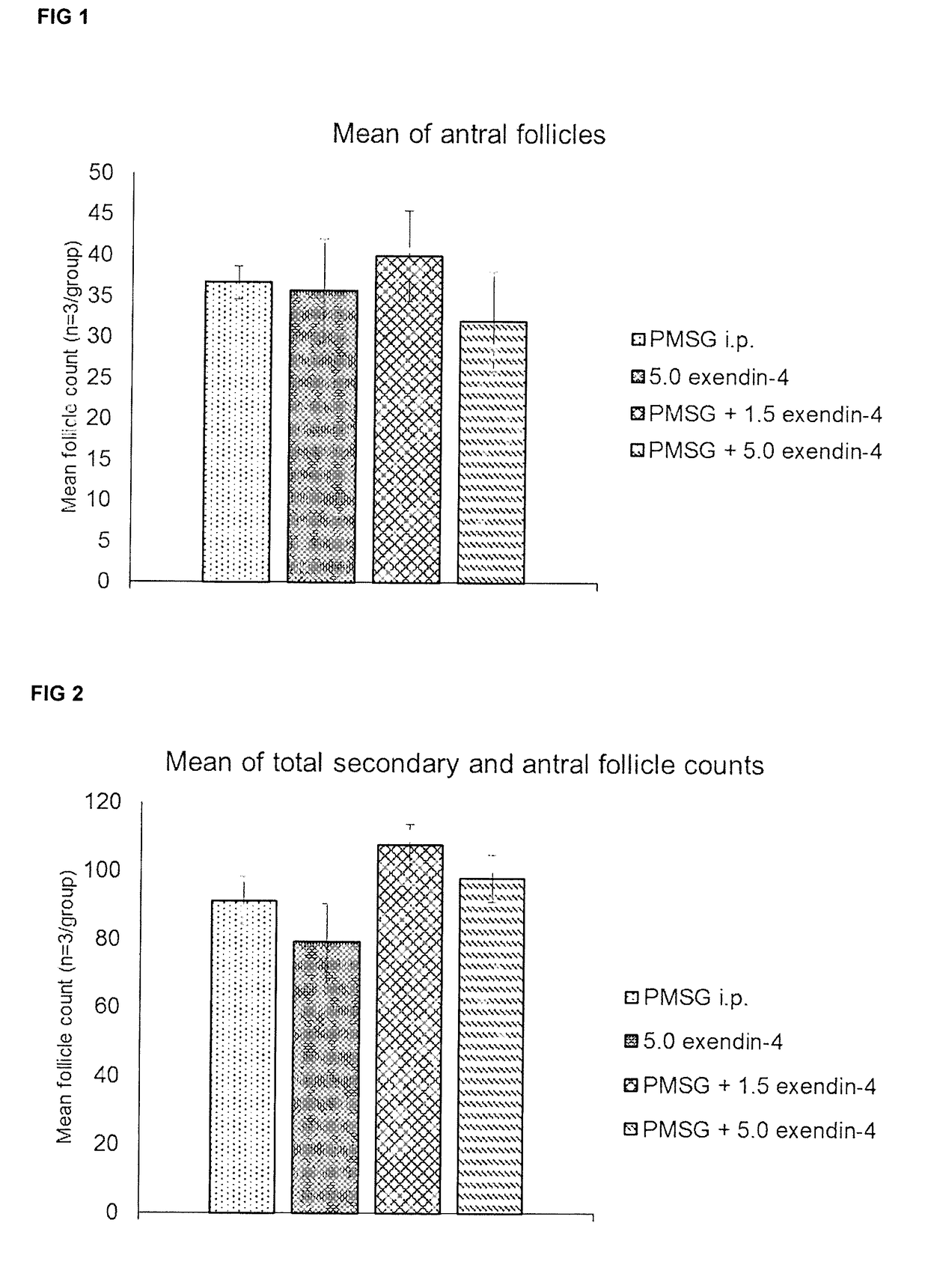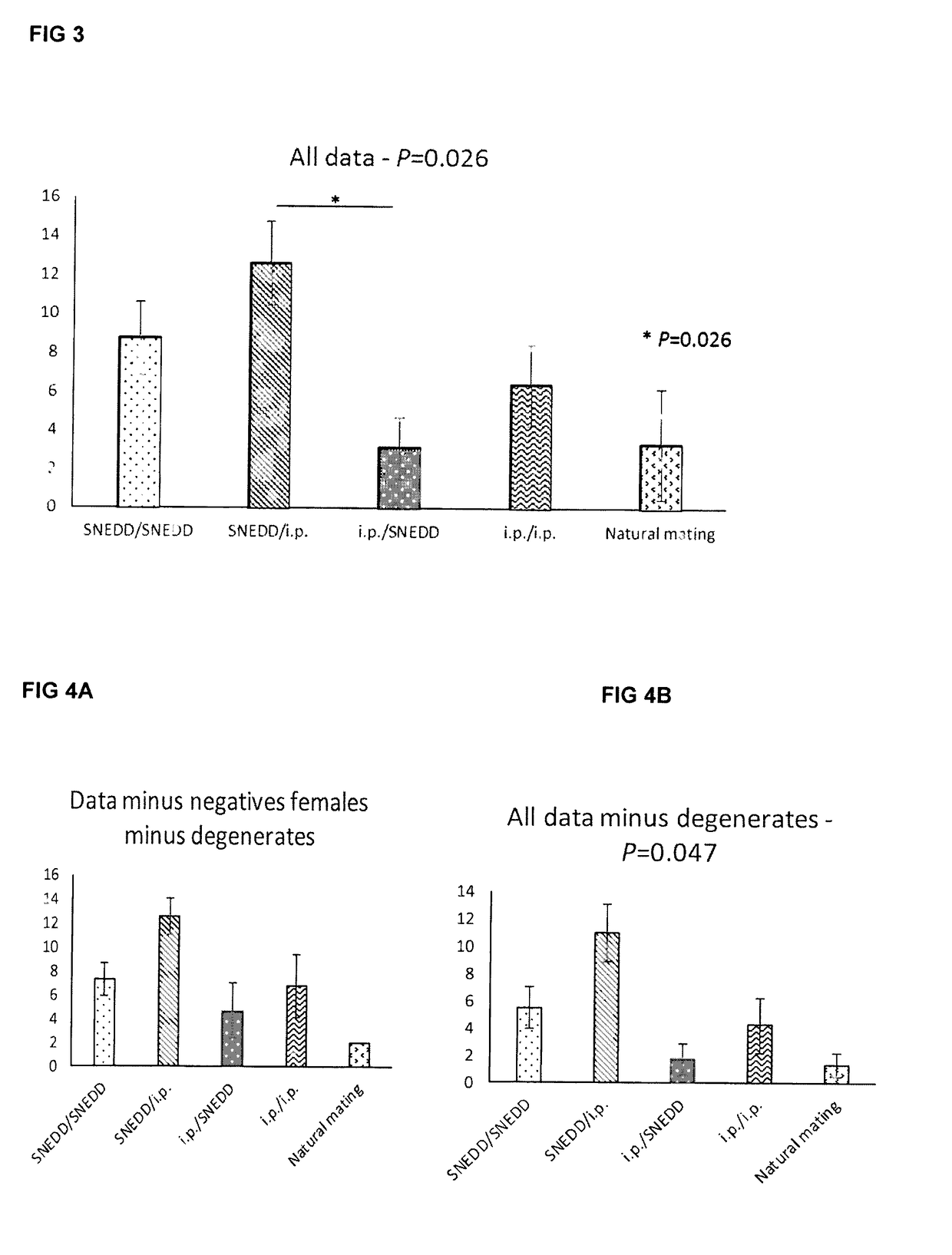Methods and compositions for managing reproduction
a technology of compositions and methods, applied in the field of methods and compositions for managing reproduction, can solve the problems of large variation in success rates and requires a skilled operator
- Summary
- Abstract
- Description
- Claims
- Application Information
AI Technical Summary
Benefits of technology
Problems solved by technology
Method used
Image
Examples
example 1
[0076]Mice were administered with a standard intra-peritoneal injection of 5 IU pregnant mare serum gonadotrophin (PMSG) to induce ovulation during oestus or dioestrus, the control being mice were injected with 1% Brij 58. Test mice were given an intravaginal pessary loaded with 15 IU PMSG, 10% citric acid the control being a pessary loaded with 10% citric acid alone. Results shows that ovulation was achieved in mice given the standard induction by the i.p route but that mice treated with pessaries loaded with PMSG did not achieve desired release of ovarian follicles. This indicated that merely loading pessaries with active ingredients in the absence of either a permeating enhancer or a mucoadhesive is insufficient to induce ovulation.
example 2
[0077]35 μl of a self-nanoemulsifying drug delivery (SNEDD) based formulation was administered into 3 mice, with observations over 24 hours. No adverse events were observed and the formulation was well tolerated. Full in vivo evaluation was then conducted with mice being divided into either i.p. (intraperitoneal) or p.v. (per vaginum) PMSG delivery. Mice were culled at 0, 2, 4, 6, 24 and 47 hours and ovaries / serum collected for analysis. Results showed that initial surface follicle counts at 24 and 48 hours were roughly equivalent between i.p. and p.v. PMSG delivery and that serum PMSG profiles, measured by ELISA at 0, 2, 4, 6, 24 and 47 hours with p.v. delivery broadly mirroring i.p. delivery with peak serum PMSG levels occurring in the first 6 hours (data not shown).
example 3
[0078]Experiments were conducted to explore the use of exendin-4 as an exemplar of a follicle stimulating agent either alone, or in combination with PMSG, to increase follicular recruitment, and to determine whether exendin-4 could have the desired effects when delivered per vaginum (p.v.), thus avoiding the need to inject.
[0079]CD1 mice received either 1.5 or 5 nmol / kg body mass of exendin-4 in a 35 μl vaginal flush. Exendin-4 (RC762-12, Generon) was reconstituted according to the manufacturer's guidelines, and further diluted in sterile PBS with 0.5% BSA (A8806, Sigma-Aldrich). The treatment groups were as follows:[0080]1. 5 IU PMSG i.p. (control)[0081]2. 5 nmol / kg exendin-4 flush[0082]3. 5 IU PMSG i.p.+1.5 nmol / kg exendin-4 flush[0083]4. 5 IU PMSG i.p.+5 nmol / kg exendin-4 flush
[0084]Treatments were given and animals were sacrificed by cervical dislocation 47 hr after treatment to coincide with the timing that hCG would be given in a typical superovulation protocol. Ovaries were e...
PUM
| Property | Measurement | Unit |
|---|---|---|
| time | aaaaa | aaaaa |
| thickness | aaaaa | aaaaa |
| thickness | aaaaa | aaaaa |
Abstract
Description
Claims
Application Information
 Login to View More
Login to View More - R&D
- Intellectual Property
- Life Sciences
- Materials
- Tech Scout
- Unparalleled Data Quality
- Higher Quality Content
- 60% Fewer Hallucinations
Browse by: Latest US Patents, China's latest patents, Technical Efficacy Thesaurus, Application Domain, Technology Topic, Popular Technical Reports.
© 2025 PatSnap. All rights reserved.Legal|Privacy policy|Modern Slavery Act Transparency Statement|Sitemap|About US| Contact US: help@patsnap.com


